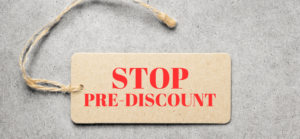In the first Value Tables post, you learned about the first four columns, PSRV, Problem, Solution, Result, Value. The substance of the table is the value column.
It is very hard to do the Problem and Results column without knowing where you are heading in terms of value. But it’s also very hard to do the value column without knowing the problem and the result. For that reason, we are going to start with the Value column. Then we will go to the problem and the result columns in the next post. We will revisit value after that.
Quick preview. In the future, value will be more than one column. For now, it is a single column.
Our goal, especially in the B2B world, is to put a dollar value in that column for every marketable feature. That number isn’t a guess. It’s a calculation based on business acumen. When a salesperson has a value conversation with a buyer, that number is provided by the buyer, not the salesperson. This implies that value is different for each buyer, which it is.
The easiest way to learn about value tables is to start with a single buyer in mind. Then consider a single feature or the product as a whole. How much value in dollars does that product or feature provide to that buyer?
Let’s do an “easy” B2C example, solar energy. Bob’s house has a South facing roof. He uses 800 kWh of electricity per month. A solar expert explains to Bob that his roof will hold enough panels to produce about 400 kWh per month. Saving 400 kWh per month would save Bob $50 per month. How much value will Bob get? If he believes those numbers, he gets $50/month.
Helping Bob determine value takes business acumen. That requires knowing your product and the buyer’s situation.
Let’s talk about a B2B feature. In LinkedIn Sales Navigator there is a feature that allows the user to enter characteristics of their ideal buyers and Sales Navigator will suggest companies and people to prospect. What is that worth to a buyer? It takes business acumen. Here are two different ways you might be able to figure it out.
Cost savings: How much time does a salesperson currently spend looking through lists of possible clients to find ones that meet the ideal profile? Let’s say 30 minutes a day. That is 1/16th of a salesperson’s time. If your salesperson is making $200,000 per year, that’s about $100 per hour. A salesperson “spends” $50/day looking for new prospects. Count 250 working days, that feature saves the client $12,500. Wow.
Increased revenue: Giving a salesperson 30 minutes more a day to sell is giving them 6.25% more time to sell. If the average salesperson sells $3M per year, that could be worth an additional $187,500 in revenue. If the client’s profit margin is only 25%, that’s an additional $46,875 in profit. That’s a lot of value.
These value numbers are not true for every client. In the beginning, think about a single customer. The key is creating the business acumen to be able to put a dollar value here. You have to understand your client’s business.
Hopefully, you are getting the idea. We will dig deeper into this column later. For now, here are three key points to remember for the value column.
-
Value is different for every customer. Your goal is to know how to find it.
-
There may be multiple ways to determine the value. Which way does your customer do it? It only counts when your customer believes it.
-
In a sales situation, the buyer should provide the numbers. The salesperson’s job is to help the buyer think through the situation.














